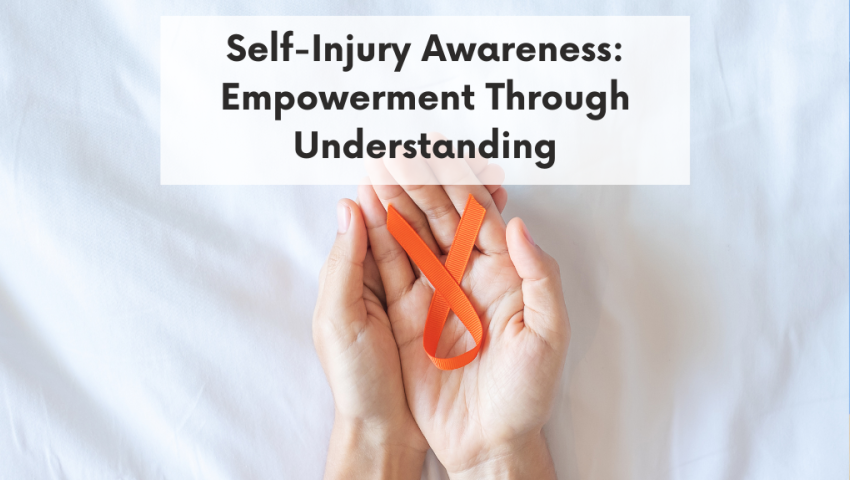
Self-Injury Awareness Month
March is designated as Self-Injury Awareness Month to highlight self-injury which is often misunderstood, not discussed, or simply suppressed. It can be difficult to understand self-injury and it is a challenging topic for many to discuss. So, we welcome you to delve deeper into this topic with us.
This blog is dedicated to casting light on this misunderstood and stigmatized issue by providing insights, resources, and support for those who may be struggling with self-harm or are seeking guidance on how to help loved ones struggling with self-injury.
With Non-Suicidal Self-Injury (NSSI) being a pervasive global public health issue, it is important that this topic be brought out of silence. According to the Centers for Disease and Control (CDC), more than one in five adults in the U.S. live with mental illness and over one in five youth either currently struggle or have previously struggled with mental illness. While NSSI is most common among adolescents (15-20%), around 6% of adults also face the challenge of self-injury (Klonsky, 2014).
What is Self-Injury
According to the Substance Abuse and Mental Health Services Administration (SAMHSA), Non-Suicidal Self-Injury (NSSI), also referred to as self-harm, is when an individual attempts to cause harm or potential injury to their body on purpose but without intending to cause death. Those who struggle with NSSI are at a higher risk of attempting suicide and dying by suicide if they do not receive help. In fact, studies have shown that NSSI is one of the strongest longitudinal predictors of future suicide attempts, even stronger than the predictive strength of prior suicide attempts (Wang et. al, 2024).
Understanding Self-Injury
The first important step to understanding self-injury is to recognize what motivates someone to engage in self-harm. There are different reasons for NSSI, so the best way to assist someone is to address what the underlying issue is.
Those who struggle with self-harm may use it to control negative feelings, dissociate from emotional pain, and cope with stress. A study noted that 85% of participants cited that their most common reason for self-injury was to release emotional pressure and that the next most common reasons were to control negative feelings and get rid of intolerable emotions (Klonsky, 2009).
Forms of Self-Injury
Individuals cope through various types of self-harm. Some might be easier to spot, while others may not be as noticeable. Recognizing different methods and signs of self-harm can help provide better support to those who are struggling.
Examples of Self-Harm:
- Cutting one’s skin with a sharp object
- Piercing one’s skin with sharp objects
- Hitting or punching oneself or punching things
- Burning oneself with cigarettes, matches, or candles
- Breaking bones or bruising oneself
- Scratching or picking scabs to prevent wounds from healing
- Pulling out one’s hair, eyelashes, or eyebrows with the intention of hurting oneself
- Inserting objects into one's body
Signs of Self-Harm:
- Scars
- Wearing long sleeves or pants, even in hot weather
- Talking about feeling worthless or helpless
- Fresh cuts, bruises, bite marks, or burns
- Keeping sharp objects on hand
- Frequent reports of accidental injury
- Emotional and behavioral instability and unpredictability
- The most common target areas of the body for self-harm are the arms, legs, chest, and stomach. Although these are the most vulnerable to enduring self-injury, any part of the body can be harmed through various methods.
Breaking the stigma on the topic of self-injury is important for the well-being of those who struggle with it and to promote advocacy, understanding, and empathy within our communities. By discussing the challenges of self-harm and how to identify warning signs, we can create a safe space where individuals feel more empowered to seek help. As we continue to educate ourselves and support those who self-harm, we break down barriers to healing and foster recovery.
If you or someone you love is experiencing or considering self-injury, please dial 988, the Suicide and Crisis Lifeline. There is hope. There is help.
The Behavioral Health Wellness Environments for Living and Learning (BH WELL) research team exists to promote behavioral health and wellness among individuals facing behavioral health challenges. To learn more about BH WELL, visit our website. Interested in more evidence-based, free mental and behavioral health resources? Follow us @ukbhwell on Instagram, Facebook, and Twitter.
References
Klonsky, E. D., Victor, S. E., & Saffer, B. Y. (2014). Nonsuicidal self-injury: what we know, and what we need to know. Canadian journal of psychiatry. Revue canadienne de psychiatrie, 59(11), 565–568. https://doi.org/10.1177/070674371405901101
Klonsky, E.D., (2009). The functions of self-unjury in young adults who cut themselves: clarifying the evidence for affect regulation. Psychiatry Research, 166(2-3), 260-268. https://doi.org/10.1016/j.psychres.2008.02.008
Wang, Z., Li, D., Chen, Y., Tao, Z., Jiang, L., He, X., Zhang, W. (2024). Understanding the subtypes of non-suicidal self-injury: A new conceptual framework based on a systematic review. Science Direct. 334, https://doi.org/10.1016/j.psychres.2024.115816
Centers for Disease Control and Prevention. (2023, April 25). Learn about mental health. https://www.cdc.gov/mentalhealth/learn/index.htm
Substance Abuse and Mental Health Services Administration. (2023, April 24). https://www.samhsa.gov/mental-health/self-harm
Centers for Disease Control and Prevention. (2019, September 17). Preventing self-injury. https://www.cdc.gov/ncbddd/disabilityandsafety/self-injury.html
Centers for Disease Control and Prevention. (2020). Evidence-based resource guide series: Treatment for suicidal ideation, self-harm, and suicide attempts among youth (Publication No. PEP20-06-01-002). chrome-extension://efaidnbmnnnibpcajpcglclefindmkaj/https://store.samhsa.gov/sites/default/files/pep20-06-01-002.pdf